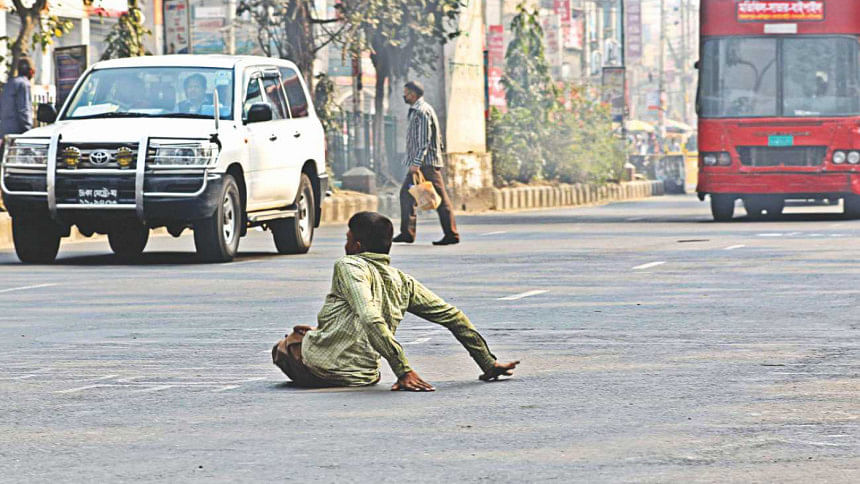Is this our city?

In this city of 14.5 million people, at least 9.07 percent of its inhabitants have some form of physical disability, according to Household Income Expenditure Survey 2011 of Bangladesh Bureau of Statistics. This means that around 1.4 million citizens of Dhaka are physically challenged. However, when we see an amputated man struggling to cross a busy street after having failed to climb the towering footbridge, it becomes apparent that the city offers little to these citizens with special needs.
"Our sufferings start right from the moment we step out from home. We can't walk freely; most of the times we have to depend on others for crossing a road or for boarding a public transport. Sometimes we don't get any help and we get harassed by the miscreants. We are also extremely vulnerable to road accidents and hijacking," says Mahbub Alam, a visually-impaired student of Dhaka University.
According to Accident Monitoring Cell of Bangladesh Road Transport Authority (BRTA) and Dhaka Metropolitan Police, pedestrians are the most vulnerable commuters of Dhaka city. Imagine, then, the plight of the physically handicapped pedestrian! For them, using a footpath is nightmare. Most of the footpaths are so high and in such derelict condition that a wheelchair user or a visually impaired person is forced to use the street no matter how risky it is. Even if they use the footpaths, these people, especially the visually impaired, are at a high risk of fatal accidents as they get no indication of where the footpath starts and where it ends. "Also the authorities installed pillars on the footpaths to prevent motorbikes from riding on it. Nobody thought that these pillars are also obstacles for a physically challenged person," says Shahin Alam, a wheelchair user who works for an NGO.
Their vulnerability becomes extreme when they have to cross the busy streets of Dhaka. The city mostly depends on footbridges and under-passes to connect both sides of the streets for pedestrians. However, almost all the footbridges of Dhaka city have steep stairs which are absolutely inaccessible to persons with disabilities.
Meanwhile, zebra crossings, which experts cite as an effective and easy means of street crossing for the disabled, ailing and elderly people, are hardly maintained in Dhaka. "Very few intersections of the city streets have zebra crossings. We found that most of the existing zebra crossings have become unusable as their white markings have faded. The city corporations have been investing on building more footbridges--prioritising vehicle movement over pedestrian's accessibility. But if signal posts can be installed in every zebra crossing and traffic law can be enforced properly, street crossing becomes easier for all people and state funds can also be saved," says Maruf Hossain, programme manager of Work for a Better Bangladesh Trust, an organisation which has been focusing on disability rights under the programme 'Ensure Our Rights'.
However, the city corporations claim that they have already taken steps to ensure accessibility of people with disabilities. "We are planning to install footbridges with escalators so that these can be climbed easily. We are regularly colouring the zebra crossings but due to lack of knowledge about traffic rules it will take time to make zebra crossings function properly," says Farazi Shahabuddin Ahmed, chief engineer of Dhaka South City Corporation.
Md Sharif Uddin, superintendent engineer of Dhaka North City Corporation, also reiterates such promises and says that they have taken steps to install blind strips (tactile dotted tiles which can be discerned with white sticks) on the footpaths and have already installed those in Gulshan avenue and Kamal Ataturk avenue.
There are positive initiatives but due to lack of sustainable planning and knowledge about disability, many of these initiatives fall short of ensuring an accessible city for a large segment of the population. For example, the first footbridge in the city with an escalator still remains unusable by people with disabilities as they would have to climb two layers of staircases to reach the escalator. In this regard, organisations working for disability rights should come forward to make government officials and the general public aware of the challenges and rights of the people with disabilities so that they consider these human rights issues before designing and implementing any development project.

 For all latest news, follow The Daily Star's Google News channel.
For all latest news, follow The Daily Star's Google News channel. 



Comments